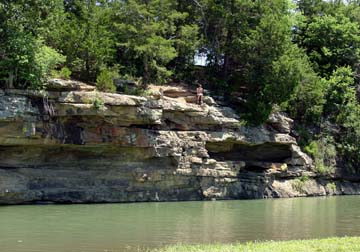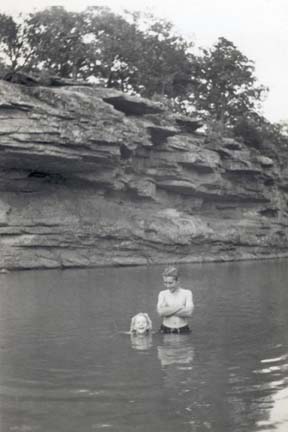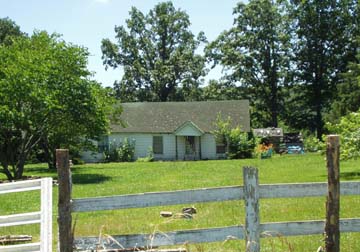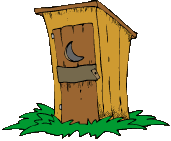1948 : Fifty-five years ago the Franklin family packed up and left their little forty-acre farm outside of West Fork, Arkansas and returned to Burden, Kansas, from whence they came. I was about eleven years old and what I didn’t realize at the time was that brother Bill and I had accrued and packed up memories of the best years of our life. I still have mine. Bill does too and has written extensively about them.
June 26, 2,003 : Emory Lewis and I sallied forth from Burden on our way to Arkansas with one main objective: getting a picture of the old Bethlehem Church for Bill. We were well equipped with every communication device known to man. Emory brought a laptop with GPS, cell phone, digital recorder and of course, digital cameras, his and mine.
Since Bella Vista, Arkansas is on the way, I planned a stop at Ken and Kathy (Belew) Murphy’s place. As soon as we arrived at the Welcome Center in Bella Vista and called, Kathy answered. It turned out that her house is right up the hill behind the Welcome Center. Their street is a winding, rocky road. These primitive roads are everywhere it seems. However, the town is beautiful and thoroughly modern.
Bella Vista is near Bentonville, the headquarters of Wal-Mart, and traffic is bad. When you start up Murphy’s road, you leave all that behind and you’re in a different world. You’re in the woods and the area is littered with abandoned cabins/shacks left to fall down and return to Mother Earth. Maybe one out of eight of these cabins is occupied. Most are nearly hidden from view with a lush growth of . . . everything, including giant old black oak trees. All kinds of beautiful wild flowers line every twist and turn in the road.
Kathy and Ken are avid gardeners and their terraced yard abounds with plants and flowers, but by now Ken can’t remember what has been imported and what is wild growth. It’s all beautiful, so it doesn’t matter.
After a short visit we found a motel in Bentonville. Other than the O2 machine, I travel light with two suitcases (grocery sacks with handles).
Past Fayetteville, Arkansas and approaching West Fork, I begin to choke up with emotion. I had forgotten how the hills look, and didn’t think I would ever get to see them again. I began to wonder if I would remember or recognize anything at all. I did. The first thing I recognized was the swimming hole at West Fork with the bluffs as a backdrop. The river is the West Fork of the White River. I remained choked up until we left the West Fork area an hour or two later.


There was really good food, more gravel roads, and wild blackberries ripening. There was a quarter mile of wild blackberries, along a fence in all stages of ripeness, that stands out in my memory. I found our old house. There were many other abandoned and falling-down buildings and houses, wildflowers, trees, huge trees.

I thought about what Charles Doyle had said about depression times when people came and would find an abandoned cabin, move in and live there. I guess that explains why the poverty level was so prevalent at the time we lived there.
I found our “Indian Bluffs” and Winn Creek and that’s about all I recognized. We looked extensively for the Bethlehem Church and either we missed it, or it’s gone. I’m so sorry Bill. I rather think we missed it since it doesn’t look like anything is ever torn down, but rather just left to rot. We did find the “new” Blackburn Church, which is old now.
We stayed overnight in Bentonville again. When I was ready to come home, I clicked the heels of my shiny red shoes three times and Toto and I were home in Kansas by 1:30 p.m. on Saturday.
I thank Emory for making the trip possible for me, catering to my every whim, fighting the traffic, loading and unloading, procuring donuts, finding the way, and for being sweet and indulgent at all times. I did nothing but enjoy the trip. Thank you, my brother Bill, for documenting the area, and Charles Doyle for his wonderful contributions. Thanks also to Ken and Kathy for their hospitality. Don’t worry, you guys, if they won’t sell the abandoned cabin next door, where a refrigerator is propping up the front porch, enjoy the view. It is a precious memento of times gone by and a monument to someone else’s creative determination to live on the side of a hill.
 Not related to our visit to the Ozarks, I have a story to tell about Bill. We were waiting for the school bus in front of our house in Arkansas. I was about 10 and he was 13. Bill went someplace, and I thought he had gone back in the house for something. The bus arrived and I got on . . . no Bill. I kept telling the bus driver that Bill would be right out. The driver waited as long as he could and finally drove away. I found out later that Bill had been in the outhouse, which was in plain sight of the bus, and was too embarrassed to come out with everyone watching. Life goes on.
Not related to our visit to the Ozarks, I have a story to tell about Bill. We were waiting for the school bus in front of our house in Arkansas. I was about 10 and he was 13. Bill went someplace, and I thought he had gone back in the house for something. The bus arrived and I got on . . . no Bill. I kept telling the bus driver that Bill would be right out. The driver waited as long as he could and finally drove away. I found out later that Bill had been in the outhouse, which was in plain sight of the bus, and was too embarrassed to come out with everyone watching. Life goes on.
Annette (Franklin) Reynolds June 2003
A map of the Bethlehem Road area is shown from the main menu.
I was testing reactions to a story I'd just finished, "The Arkansas Traveler". Hostile critics only guessed, as I had also done, about current conditions on Bethlehem Road (Blackburn Road in the story). My sister postulated a welfare state, and my son does not believe such an undeveloped environment exists outside of rural Mexico. In the spring of 1995, I went there to verify economic conditions. I apologize to these people and thank them for destroying my romantic dream.
Of course, things have changed in the 35 years since my last trip. The road has been improved and is constantly maintained. Telephone and, probably, TV signals have been introduced by buried cable. Liquid propane is utilized at a few locations, demonstrating an increased affluence. Nearly every home has at least one operable vehicle to supplement the rusted junker, melting into its front yard. And parcels of land have been sold for home development, increasing housing and population density by a factor of about four.
We can delight in the Woolsey Church, well kept as always, and the railroad trestle over West Fork Creek at the same location. A low-water bridge has replaced the swinging footbridge across Winn Creek at Indian Bluff. A bulldozer and ton of dynamite took care of the tree root near the top of Indian Hill (Caudle Hill). Extensive additional clearing supports cattle ranching, which seems to have replaced poultry and berry farming. Lespedeza is rare. I spotted a couple of hog farms. The old cemetery has been assimilated into pasture, and the wagon trail into Lee Creek is enjoined with a familiar no-trespassing sign.
My father and Ed Koch, who owned the property, made an effort to retrieve the excellent hay from Lee Creek bottom in the late forties. Without the wider cooperation that I outlined in our story, it was not practical. Only one available team meant two trips to get the required equipment (mowing machine and wagon) there, and two trips to get them back out. Mom, Annie, and I portaged food to them on the second day.
During my 1995 visit, I identified our old home (Merqueset house in the story) and wallowed in nostalgia, so frequently visited on old folks. I tried to see Mother washing clothing on a wash board, the child Annette scattering cracked corn for the chickens, Dad turning the horses loose after a day in harness, and Tony and Toby frolicking away like colts. There goes myself, as young Bill, whooping, “Sook Boss, sook Boss!”, walking to the barn to milk our cow. The visions faded, and young Bill was gone.
Two miles short of the junction of Memory Lane with the Devil’s Den State Park road, the Bethlehem Church (Blackburn Church in the story) stands on the west side of the road. Long ago, one evening a month, an enterprising outsider used the building to show an hour (two episodes) of a Zoro or Lone Ranger serial movie for 15 cents per head. He used a portable generator to run his projector.
The church is now in the last stages of decay, slightly tipsy and its weathered bell tower full of bird nests. I stood in the doorless entry to see that it had been electrified and the interior improved with sheet rock sometime in the last 45 years. I picked the remains of a book from the trash on the rotted floor — it was a school text of junior-high level, a hint of the venerable structure’s last use. It suggested a fictional story, about an irretrievable tradition, that I had already written. Goose flesh overcame me as I wondered about this coincidence. Or had history brushed closely enough with fantasy to somehow influence both?
An abandoned general store, at the junction of Bethlehem Road with the road to Devil’s Den, once carried the name of Blackburn. The state-park road was unimproved when I lived there but had been paved at the time of a visit in 1960, removing all traces of the structure. But as things change, the more they stay the same — a building stands a half mile west down the Park road with a sign identifying it as the Blackburn Community Church. Charles Doyle says this church has been here as long as he can remember.
The setting for my story is current-day, but the circumstances are the way they were, oh God, so long ago. I won’t rewrite it to correct my naive assumptions but will cover the anomaly by offering it as documentation for a culture that has disappeared.
 (postscript 2003) The previous account is from the Epilogue of "The Arkansas Traveler". I finally
have the nerve, eight years later, to elaborate my hair-raising experience at Bethlehem
Church. I had picked the book from the floor and identified its contents. Leaving the room, I noticed a broken wristwatch band that I'd written into the story. Standing in the doorway, I realized the implications of the old text in my hand, the improvements to the building, the watch strap. The church's long history settled over me with a spooky feeling, and I resisted an impulse to flee from the unknown. I wondered what would happen if I held the old book, read a passage from my story, and turned around three times. I didn't because I don't believe in that stuff.
(postscript 2003) The previous account is from the Epilogue of "The Arkansas Traveler". I finally
have the nerve, eight years later, to elaborate my hair-raising experience at Bethlehem
Church. I had picked the book from the floor and identified its contents. Leaving the room, I noticed a broken wristwatch band that I'd written into the story. Standing in the doorway, I realized the implications of the old text in my hand, the improvements to the building, the watch strap. The church's long history settled over me with a spooky feeling, and I resisted an impulse to flee from the unknown. I wondered what would happen if I held the old book, read a passage from my story, and turned around three times. I didn't because I don't believe in that stuff.
Instead, I went to my '80 Datsun, which I'd used as a model for the heroine's auto in the story, and sat on corn chips, also from the story. Pulling out a draft of "Arkansas Traveler", I looked at my surroundings for story continuity. It was eerie. Except for the advanced age, everything was as I remembered or had fabricated. I sat under the pines about where, in the story, James Drew had parked on the eve of Big Oatmeal Cookie Day. Where the limousine from hell had struck Drew's vehicle, I sat on shards of the broken headlight.
That was too much for me. I gathered my things and drove on down Bethlehem Road toward the Devil's Den Park road.
Well, it is time for me to go behind the smokehouse and pick ticks. Bill Franklin loves you.
Horses and cow had a unique pecking order. There was only room for two of these large animals at the manger. Toby, the brown gentle horse, liked the cow and would share with her side by side. Tony, the white ornery one, would bite the cow on the butt to dislodge her from the manger. It didn't work because Bessie would lash out and kick him. So Tony would bite Toby on the butt. Toby would yield and stand patiently until the others had their fill. Toby was not subordinate to the cow but seemed to like her. When he saw that she wanted in to the manger, he would back out and even nuzzle her with his nose.
At pasture, ornery Tony would be seized by an impulse to torment the cow. His eye lids would lower, white eye lashes radiating evil, his ears would lay back and he would nip Bessie's flank, being careful of rearward kicks from the cow. He would rear up and gallop around to bite the other side. Toby would see this and start biting Tony, to protect the cow I think. This exchange developed into a playful chase by the horses as the cow continued to graze serenely. I have a memory, like a movie playing in my head, of those horses, chasing one another, shaking their heads from side to side and making grunting snorting noises as they galloped. I think that head shaking is some kind of horsy talk that means "don't tread on me".
Annie related why she was afraid of Tony — he reared up at her, front hooves flailing, and Daddy beat the hell out of him. That's the same horse that pinned me to a stall wall and Dad walloped him a good one. Same horse that hated the car — every time we left a window down, he would tear chunks from the upholstery with his teeth. Same horse ate the kitchen curtains. Same horse slipped on cement and fell with a resounding fart that cracked the cement (that one was an accident, playing chase around the house).